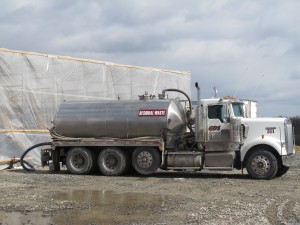EPA releases first part of frack study, an analysis of chemical disclosure

Susan Phillips / StateImpact Pennsylvania
A truck delivers drilling waste water to a frack water recycling plant in Susquehanna County
The Environmental Protection Agency released an analysis of frack water on Friday, based on data that drillers supplied to the website FracFocus. The EPA’s report is just one part of the agency’s long awaited fracking study, which will assess the impacts of hydraulic fracturing on drinking water supplies. The full report is due out this spring.
The EPA researchers say less than one percent of frack fluid in their analysis of 39,000 wells contained additives, while water made up 88 percent of the fluid, and sand, or quartz, made up ten percent. The agency identified 692 separate frack water ingredients. Maximum concentrations of these chemicals were usually below 2 percent of the total mass, while half of the chemicals were below 0.3 percent of mass. EPA science advisor Tom Burke told reporters on a press call that the chemical additives and volumes of water varied greatly from well to well. Water usage for each fracked well ranged from 35,000 gallons to 7.2 million gallons.
“While these maximum concentrations [of chemical additives] are low percentages of the overall fracturing fluid,” said Burke, “more than half the wells had water volumes greater than 1.5 million gallons. So a small percentage may mean hundreds or thousands of gallons of chemicals could be transported to, and present on, the well pad prior to mixing on the fracking fluid. Remember one percent of a million gallons is a large number — 10,000 gallons.”
The three top chemicals used in the frack fluid were hydrochloric acid, methanol, and hydro-treated light petroleum distillates. Hydrochloric acid is used to keep the well casings free of mineral build-ups, while methanol is used to increase viscosity. Petroleum distillates are refined products like diesel, kerosene, or fuel oil, and are used to make the fluid “slick,” or soapy, and thereby reduce friction.
Producers have steered away from using distillates in their fracking fluids in recent years to avoid stricter federal regulations. The so-called Halliburton Loophole in the Energy Policy Act of 2005 exempts chemicals used in hydraulic fracturing from federal oversight. But diesel is an exception. That’s because it moves quickly through water, and even small amounts of the neurotoxins within the liquid fuel cause liver and kidney damage.
The agency analyzed the information provided to FracFocus for a two-year time frame stretching from January, 2011 to February, 2013. During that time, the reports show that drillers in Pennsylvania used about 11 billion gallons of water to frack 2,483 wells.
With funding from industry trade groups, FracFocus launched in April 2011 as an optional disclosure tool. The effort was a response to criticism regarding industry exemptions from several federal environmental regulations, which would have required chemical disclosure, among other things. More than 200 operators voluntarily uploaded their fracking fluid recipes for each well – with the exception of those ingredients companies deemed “trade secrets.”
FracFocus is run by the Interstate Oil and Gas Compact Commission and the Groundwater Protection Council, both based in Oklahoma City. The IOGCC is a multi-state government agency and the GWPC is a nonprofit group of state regulators who oversee water quality and oil and gas development. Pennsylvania is a member of both organizations.
Jeanne Briskin, coordinator for the EPA’s frack study, praised both the Groundwater Protection Council and the IOGCC for their cooperation. A recent report by Inside Climate News revealed that the EPA’s fracking study has been stymied by industry players who have thwarted efforts to collect good data.
“This is one source of data to help us understand the frequency of chemical use, and the amounts of water used,” said Briskin.
But the report also has limitations. Tom Burke told reporters that the information is underestimated due to the fact that not all states required companies to report their water and chemical usage, and industry could refrain from reporting anything it deemed a “trade secret.”
Seventy percent of all well reports included at least one undisclosed entry due to trade secret claims.

Susan Phillips/ StateImpact Pennsylvania
Kim McEvoy of Butler County is among the people who believe gas drilling ruined their drinking water.
StateImpact has reported on the difficulties associated with how FracFocus makes their data available to the public. Each report is in a PDF file, which makes it difficult to do any type of analysis. PDFs are not “machine-readable.” In other words, computers can’t understand the documents, so it’s harder to tell machines to pull the data out and organize the information as a table or a spreadsheet. (An Excel spreadsheet is one example of a “machine-readable” document.)
But FracFocus recently announced plans to improve the site. Pennsylvania requires its drillers to report the contents of frack water to the site, but reports have shown that the state provides little oversight over whether the reports are timely and accurate.
The EPA would not answer questions on the toxicity of the chemicals listed, but said that analysis would be forthcoming along with the broader report due out within the next couple of months.

















